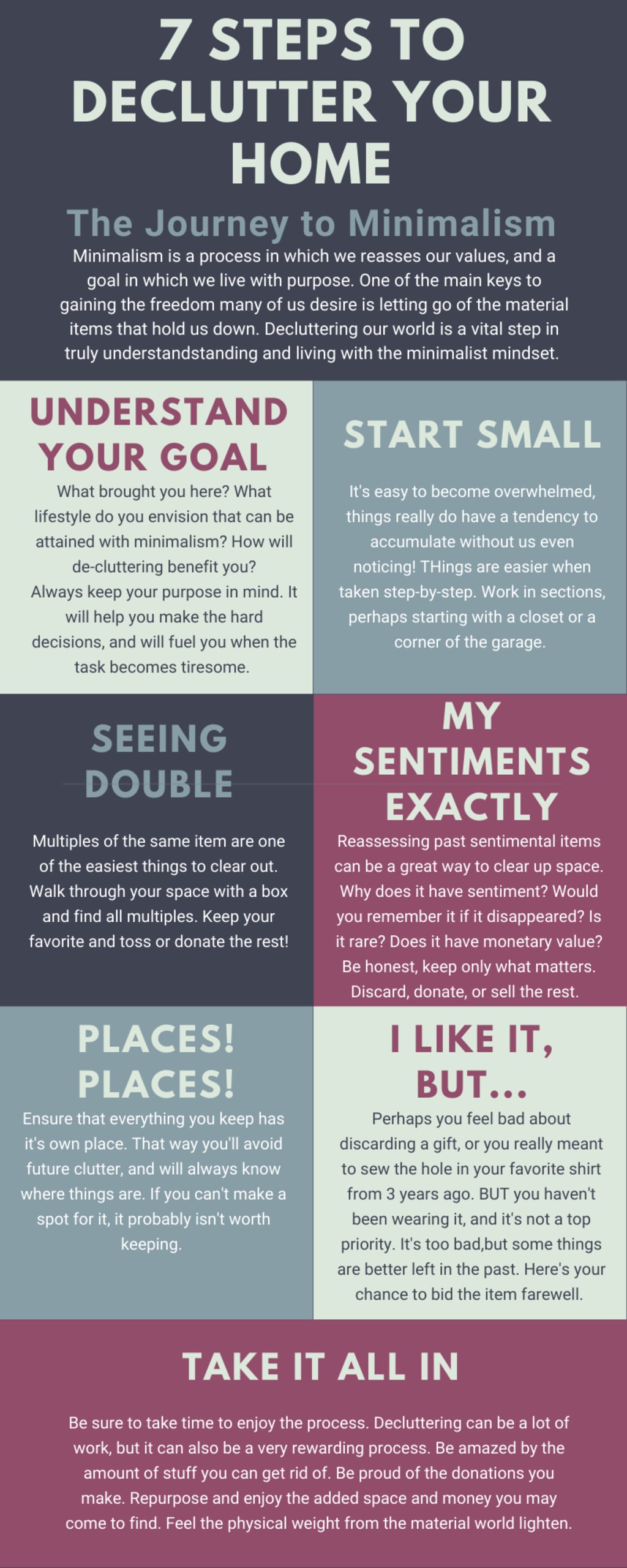
A huge hurdle on the road to minimalism is the decluttering of our living spaces. Whether this refers to a bedroom, a studio, or an entire family home, the journey begins in our daily surroundings. Don't get me wrong, it's common and not necessarily unhealthy to accumulate items over time. Remember those concert ticket stubs that were intended to end up in a photo album you haven't touched since grade school? Or the boutique's worth of scented lotions from people who felt bad not bringing a gift? And what about that pile of clothes you swear you'll mend with the new sewing machine that will instead hid on the top shelf of your storage room for the next five years? Yes, we all have something we justify keeping.
While we may have all of the best intentions in keeping many of these items, they often get stashed away somewhere, lost or forgotten. Before you know it, you have a decade's worth of things that you've put aside, things that have worn down or broken, and things you've generally accumulated. Sorting through these lost and well-used items is a freeing and regenerative feeling, and something I would recommend for everyone to do. However, this is only the first step on the journey to minimalism.When I began my decluttering process, approximately a month before I moved in order to give me enough time to , The second, but I would dare to say more important part of the decluttering process for those on the road to minimalism is the shift in perspective. I was excited to purge, and had anticipated mine for close to a year before it actually happened. However, I had not anticipated the noticeable shift in my perspective. I went from being someone who'd take free things just because they were free and who'd hold on to every sentimental token that lived stuffed in a closet, to someone who was specific about only keeping things that serve a specific purpose and who can let go of shallow sentiments that are easily forgotten. The more bags and boxes I cleared out (and I had nearly a decade's worth of miscellaneous stuff) the freer and lighter I felt. The more I realized that I so easily forgot all that I discarded, the more eager I grew to continue the purge.
So how do you draw those definitive lines in order to charge down the minimalist path? I left with two small to medium sized suitcases, a travel backpack, Duchess' bag, and a few shipped boxes of text and yearbooks.The amount of stuff I gave away to neighbors, coworkers, and friends amazed everyone who got a piece of it. And now, I'm even leaving another donation box with my family in Colorado before I leave. When I reflect on my selection process, I can break it down to 7 basic steps.
Step 1: Understand Your Goal
Your goal or reason, that underlying desire that's fueling you, is the foundation of the entire process. Come back to in times of doubt, and let it give you strength when the journey gets tough. No major change in life is easy, but it also doesn't need to be a great challenge if the desire is strong enough. I found that I initially had a harder time getting rid of things than expected, but it quickly and steadily became easier as I began to see how little I could actually own. The more my new reality came into focus, the more joy I found in working towards it, and suddenly the once daunting task of parting with the possessions I had put so much worth on became a fun and freeing task.
Step 2: Start Small
Henry Ford once pointed out that "Nothing is particularly hard if you divide it into small jobs." Depending on exactly how much you have to sort through, it can feel overwhelming and can lead to counterproductive behavior such as procrastination, avoidance, and making excuses. This is why it is important to break such a big project into smaller tasks, and to use an approach fit for your particular project. For example, one method is to divide your space into sections. If you are tackling a room, break it into sections such as the closet, a dresser, under the bed, etc. Depending on the amount of stuff there is to sort through, you may even choose to make your sections even smaller (such as tackling a miscellaneous junk drawer). Complete each section before moving to the next, and before you know it, you'll have sorted through the whole room!
Step 3: Seeing Double
Another method I came across is called the KonMari method, coined by Japanese organizing consultant Marie Kondo. This method categorizes items by type rather than dividing a space into sections, allowing you to easily spot and discard multiples of the same items. For example, one category could be linens. One would bring all towels, bed sheets, wash cloths, etc. into one place, and eliminate any undesired and unnecessary multiples before returning them to their proper place. This method is especially useful if the main purpose of your decluttering project is to downsize.
Starting off with a lot of stuff in a small space required me to implement both of these strategies. After feeling too overwhelmed to make any organizational decision from the get-go, my first priority was to get the amount of stuff I was dealing with down to a point where I could begin grouping. So I went through my space in sections, drawer by drawer, shelf by shelf, putting everything I did not have an immediate or foreseen use for into a trash or a donation bag. Clearing out this initial sweep of clutter allowed me to gain a better visual of what I actually was dealing with when it came to making the hard decisions of what I was actually taking with me on my minimalist journey, and what I had to leave behind.
Sentimental objects can remind us of loved ones, of heart-warming memories, and of notable experiences, and there's no harm in keeping these items as long as they hold value. However, the less worth we place on material items, the more easily we can see the over-sentimentality that many struggle with, and the pile-up of clutter that accumulates as a result
Step 4: My Sentiments Exactly
For many of us, parting with sentimental objects may be the hardest part of downsizing. It is an easy way to excuse holding on to things, and the nostalgia that these items are formed around has an almost innate hold on us. Sentimental objects can remind us of loved ones, of heart-warming memories, and of notable experiences, and there's no harm in keeping these items, as long as they hold value. However, the less worth we place on material items, the more easily we can see the over-sentimentality that many struggle with, and the pile-up of clutter that can accumulate as a result.
The initial shock of the finality of getting rid of things hit me harder than I had anticipated, but it forced me into recognizing and adjusting my perspective. I realized that it was difficult for me to part with things that once held worth to me, even though they no longer do, simply because I remembered when they did. Nostalgia is a powerful occurrence that can bring joy and be shared with others, but it also keeps us living in the past, and so it is crucial to be critical and realistic of sentimental items when on the path to minimalism.
So how do we determine what to keep? Well, that depends on exactly how strict you're being. If you are simply trying to weed out excess and clear up some space, then makes sure that you either can and will use the item in the near future, or that the item brings you joy. However, minimalism requires us to be more selective. If you're not sure whether to keep an object or not, I suggest going through two rounds of questions
First, ask the following questions:
• Will the item be used in the near future?
• Does the item bring you joy?
• Is the item small enough to not be an inconvenience?
• Was the item a meaningful gift?
• Is the item rare and/or a collector's item?
• Does the item have monetary value?
If the item doesn't fit into any of these categories, then it's probably time to put it into the trash pile. However, if you answered yes to any of these questions, then ask again if this item will serve a purpose to you in the near future?
If the answer is not a yes this time, then it does not fit into a minimalist lifestyle. However, there are a variety of different ways in which we can part with cherished items.
1. Some things can be recycled and re-purposed, such as in this tutorial that demonstrates how to turn old shirts into a quilt
2. Items that are still in good condition can be donated to local donations centers and shelters, or can be re-gifted to people who'll appreciate them more.
3. If the item is rare or expensive, you may want to look into selling. When in doubt, make sure you get a professional to assess it's value.For quick sales, utilize pawn shops and online marketplaces.
4. If you really can't part with an item, but temporarily don't have the space for it, consider finding a friend or family member who'll keep your item(s) safe
5. Remember that you can store TONS of pictures on cloud and hardware storage, so take pictures of items you have difficulty parting with.
Step 5: Places! Places!
When downsizing, it's important to give everything it's own place. Without set places, you automatically set yourself up for clutter, and on top of that, you are more likely to keep things that really shouldn't make the cut. Think about it; if you can't even give an item a home, is it actually that important to you? Cut out unnecessary things laying around and put things back where they belong. Being tidy is only hard if you have too much stuff.
Step 6: I like it, but..
A lot of things pile up because they're not needed or wanted as they are, but we feel bad getting rid of them. Maybe the blouse was a gift. Maybe you really intend to sew up that tear. Maybe you bought something, decided you don't really like it after all, can't return it because you already threw away the receipt and tags or packaging, and feel bad getting rid of it because you haven't even used it.
These are the types of items that, with the right perspective, should be some of the easiest to part with. Yes, it may be a shame that you or a loved one failed to buy something of value to you, but that happens sometimes, and accepting that truth allows us to let go. There's no use in keeping an item that you have no use for.
Step 7: Take It All In
From downsizing to organizing and cleaning, the entire decluttering process can certainly pile up. However, it's important to take your time and be thorough when sorting through things and making your decisions. In order to stay focus and avoid becoming overwhelmed during the project, it is important to occasionally take a break and admire your work. It is easy to get caught up in the process, and it is easy to get discouraged and frustrated when the road becomes difficult, so regularly admire the fruits of your labors will keep spirits high and energies motivated.
Though the journey to minimalism may be trying, it can also be a wonderfully enlightening, freeing, and joyous undertaking. Keep in mind that challenges are often more a feat of the mind than of the physical world. There is a quote by Wayne Dyer that clarifies this beautifully. Dyer proclaims,"When you change your way of seeing things, the things you see change."
Truth and reality are dependent on perspective, but perspective can be changed and molded. Minimalism requires a detachment from the material world, keeping only what serves a purpose. It is not valuing items themselves, for items will always come and go, but valuing the way in which they allow or enhance your experience of life. So, as you continue on your journey and when you get stuck, remember to make your decisions on function, not form. Keep only what currently serves you, and basque in the freedom of ridding yourself of that which does not.
About the Creator
Lana
Professional freelance writer and aspiring poet. I love adventures, the outdoors, and my pets, and I am always looking for new ways to learn and grow in life.






Comments
There are no comments for this story
Be the first to respond and start the conversation.